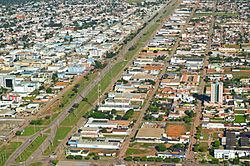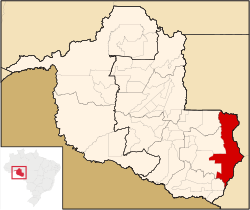Vilhena
| Vilhena | |||
|---|---|---|---|
| Municipality | |||
| The Municipality of Vilhena | |||

Aerial view of Vilhena
|
|||
|
|||
 Location of Vilhena in the State of Rondônia |
|||
| Coordinates: 12°44′26″S 60°08′45″W / 12.74056°S 60.14583°W | |||
| Country |
|
||
| Region | North | ||
| State |
|
||
| Founded | November 23, 1977 | ||
| Government | |||
| • Mayor | José Rover (PP) | ||
| Area | |||
| • Total | 11,519 km2 (4,448 sq mi) | ||
| Elevation | 615 m (2,018 ft) | ||
| Population (2008) | |||
| • Total | 68,405 | ||
| • Density | 5.5/km2 (14/sq mi) | ||
| Time zone | UTC-4 (UTC-4) | ||
| HDI (2000) | 0.771 – medium | ||
| Website | www.pmvilhena.com.br | ||
Coordinates: 12°44′26″S 60°08′45″W / 12.74056°S 60.14583°W Vilhena is the easternmost municipality in the Brazilian state of Rondônia. Its population was 77,937 (IBGE-2011) and its area is 11,519 km². It is the fifth-largest city in Rondônia and has the best HDI in the state (0,771 - UNDP/2000). According to IBGE-2008, Vilhena also had a GDP of R$1,109,445,514 (approximately US$700 million), which represented a GDP per capita of R$16,218.18 (around US$10,000,00)
In common with many other municipalities of Rondônia, Vilhena was started in the early twentieth century, around 1910, when Cândido Mariano da Silva Rondon built telegraph posts in the fields of the Plateau Parecis, linking several cities between Cuiaba and Porto Velho. Towns often would rise around these posts, Vilhena included.
Migration from southern and southeastern regions caused the population to increase in 1959 after the construction of highway BR-364, which connects the north with the rest of the country and was paved in 1986. The period in which the population rose more dramatically was the 1970s, as from 1964 many migrants from all over the country were attracted to the region because of the distribution of land to settlers by INCRA (National Institute of Colonization and Agrarian Reform). The region's wealth of wood in the forest sites and a healthy climate attracted many permanent residents, with a relevant participation of decedents from European migrants, who came firstly to the south of the country and were later attracted to this region by government incentives.
...
Wikipedia


